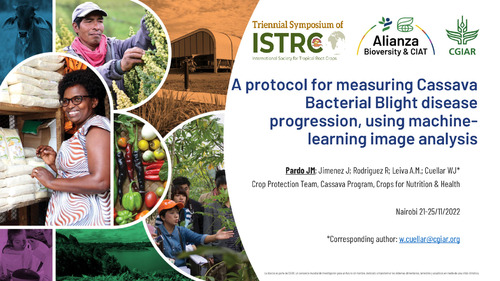A protocol for measuring disease resistance to Cassava Bacterial Blight, using machine-learning image analysis
A protocol for measuring disease resistance to Cassava Bacterial Blight, using machine-learning image analysis
Cassava (Manihot esculenta Crantz), a starchy root crop, is the fourth most important source of dietary carbohydrate in developing countries and important source of industrial raw material in tropical regions especially in southeast Asia (SEA). Xanthomonas phaseoli pv. manihotis formerly known as Xanthomonas axonopodis pv. manihotis (Xam) is the causal agent of cassava bacterial blight (CBB) disease. CBB is the major bacterial disease of cassava worldwide. To support breeding for resistance programs, we standardized a screen house protocol for the reliable, simple, space- and time-efficient and high throughput tool based on machine learning image analysis using the PhenotyperCV software. Bacterial strains from three edaphoclimatic zones in Colombia (isolates CIO 156, CIO 59, CIO 1238, CIO 482, CIAT 1075), were sequenced at the genome level using Nanopore technology and their pathogenicity profile was evaluated by inoculation in cassava leaves of 3 month old plants, under greenhouse conditions. Inoculations were carried out by infiltration using a needleless syringe of bacterial suspensions at OD600=0.05. Cassava leaves were detached from the plants and imaged at 0, 4, 6, 9, and 12-days post inoculation (DPI), and water-soaked spots were measured to calculate the area under the disease progress curve (AUDPC). This protocol allows us to identify distinct pathogenic strains and evaluate the characteristic CBB water soaked symptoms at different DPI by performing spots measurements in an automated way generating AUDPC curves over time that can be used for pathogenic characterization of isolates and subsequent varietal resistance screenings, a susceptible material will have a significantly higher AUDPC compared to a less susceptible or resistant material.
Key words: Cassava bacterial blight , screen house protocol, machine learning, pathogenicity, AUDPC.

